Safe to Travel in Chinese Tibet

July 16 – Our Publisher, Chris Devonshire-Ellis has just returned from a ten day tour to the remote, ethnic Tibetan parts of China. This is his report on the social state of the region:
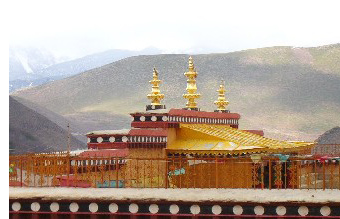 Arriving at the Gandan Sumtseling Monastery, founded by the 5th Dalai Lama, is today a rather easier experience than it used to be. Tucked into a valley at one end of Zhongdian, in the north of Yunnan, in what used to be the Tibetan Province of Kham, the drive from Lijiang to the south took just four hours. Ten years after my first visit and three since my last, the monastery was looking well. The gleaming gilt roofs looked newly burnished, with an impressive new entrance to the Gompa, and obvious major re-building of parts of what had previously been dilapidated monks quarters. The original buildings, over 300 years old, were also being repaired, improved, and updated. New laid stone paths weaved between the many buildings, and a noticeable sewage system was being put in place. Climbing up the 108 steps to the main platform of the old assembly hall, I was struck by how much it had changed. Young Tibetan monks—some 600 of them, apparently—studied in various college buildings, with senior monks and the abbot all beaming, obviously excited of the redevelopment of their home. Worshippers and the devout, locals dressed in traditional Tibetan robes, some obviously on pilgrimage, prostrated themselves, while modern Chinese travelers also raised hands together and solemnly circumnavigated the temples.
Arriving at the Gandan Sumtseling Monastery, founded by the 5th Dalai Lama, is today a rather easier experience than it used to be. Tucked into a valley at one end of Zhongdian, in the north of Yunnan, in what used to be the Tibetan Province of Kham, the drive from Lijiang to the south took just four hours. Ten years after my first visit and three since my last, the monastery was looking well. The gleaming gilt roofs looked newly burnished, with an impressive new entrance to the Gompa, and obvious major re-building of parts of what had previously been dilapidated monks quarters. The original buildings, over 300 years old, were also being repaired, improved, and updated. New laid stone paths weaved between the many buildings, and a noticeable sewage system was being put in place. Climbing up the 108 steps to the main platform of the old assembly hall, I was struck by how much it had changed. Young Tibetan monks—some 600 of them, apparently—studied in various college buildings, with senior monks and the abbot all beaming, obviously excited of the redevelopment of their home. Worshippers and the devout, locals dressed in traditional Tibetan robes, some obviously on pilgrimage, prostrated themselves, while modern Chinese travelers also raised hands together and solemnly circumnavigated the temples.
This was in stark contrast to my first visit. That trip had been a jarring ten hours, across roads made of little more than bare rocks and gravel, while the Monastery itself was run down, and melancholy in ambiance. Few monks were in situ, and it seemed a temple of faded glories past. The monastery had been quite badly damaged during the Cultural Revolution, and it appeared no one had really cared about its fate since. Suppression seemed to lurk behind every monastic doorway, with the gloom of the nearby mountains only serving to accentuate the feeling of depression.
Over the years, much has been written about China, freedom of worship, and the Tibetan issue. Most has been negative, based on hearsay, often with political grievances held aloft in an attempt to settle old scores. Things recently came to a head in Tibet itself, with scenes of monks rioting in the streets of Lhasa. The Western backlash of perceived atrocities in Tibet threatened to derail much of the passage of the Olympic flame wherever it went. To find out the real picture, I took ten days to travel in the region, much of it remote, with neither cellular mobile or internet access, and decided to go visit and see for myself. Are the ethnic areas of Tibet safe? Is there freedom of worship for Tibetan Buddhism? What is the real picture as to the state of affairs amongst the Tibetan community in China?
Lijiang, where I had flown into from Kunming, is now a major tourist destination in its own right, seeing nearly three million visitors a year amongst a population of 30,000. Parked up the lingering fingers of the Eastern Himalayas at 2,500 meters, the original old town consists of single story, traditional stone houses, with gray-tiled ornamental roofs. Tiny streets navigate their way through the houses, too small for motor vehicles: everyone walks through Lijiang.
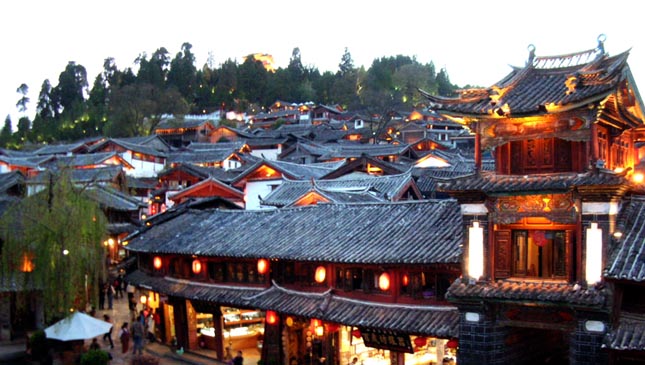
It’s not a Chinese (by which I mean Han) community, the region was settled by the Naxi minority, migrants from Northern Tibet several hundred years ago, who farmed the valley and its fertile lands. Fighting off marauding Tibetan and Chinese armies for several centuries, the region’s people have their own distinct culture. While a de facto territory of Imperial China, the truth was that the Naxi, bar an annual tribute to the Chinese emperor, were pretty much left alone to get on with life, as long as they kept a sense of loyalty to the Imperial court. Local kings therefore ruled much of the nearby areas, but any who got too zealous in attempts to claim independence would be visited by the Imperial army. China was unified, but as the saying goes, the Emperor was far away.
This had the effect however on turning areas such as Lijiang into small fiefdoms. That’s OK if everyone gets on, and abides by similar rules and laws, but not everyone did. Kings raided each others properties, Bandits ruled the roads and passes, and it was a brave soul who traveled far. Murder and robbery were highly likely if one ventured out of your home village, and this kept many communities isolated. A little know fact also was the true status of the Tibetans, and their monasteries, dotted all over the region. Lamas, revered also as kings, would pray one day, and organize pillaging tours the next. Monks would reverberate between a life of prayer and pillage – and back again. It would certainly not have been a good idea at the time to upset a lama with an army of monks to call upon.
An hour’s drive north of Lijiang sits the town of Shi Gu, famous for its location right on the first bend of the Yangtze River. The Yangtze itself originates high in the Tibetan Himalayas, and thunders down the valleys, heading south, with the apparent intent, like its next valley neighbor, the Mekong, to continue its journey and empty out into the South China Sea. Yet it doesn’t, and China’s entire nature changed as a result. Instead, the Yangtze hits a large bedrock of solid granite at Shi Gu and changes course completely, heading east across the entire country. No Shi Gu, no Chongqing, Wuhan, Nanjing or Shanghai, where the Yangtze eventually reaches the sea.
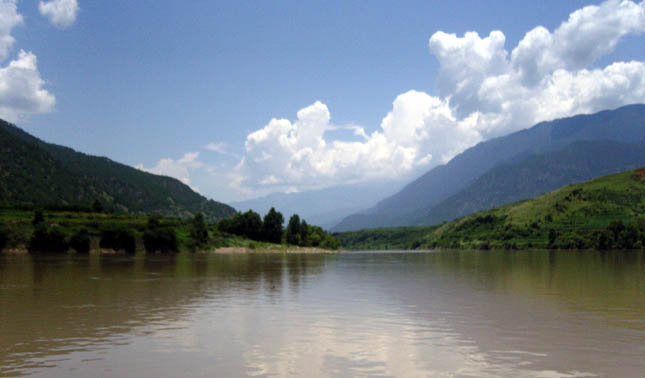
Shi Gu pays homage to a number of important military campaigns due to its strategic position. A large, ancient stone drum commemorates two military battles the local Naxi people fought with Tibetan armies, while Mao Zedong’s Communists crossed the river here during their Long March at the time of the Chinese civil war. The town itself is mostly Naxi, with Tibetan and Chinese traders, lorries stuffed full of pigs, yak hair tails, and other commodities stopping off here for a rest over from the long drive down either from or to Tibet. Up on the hill overlooking the town, a new Tibetan temple is being constructed, in traditional design.
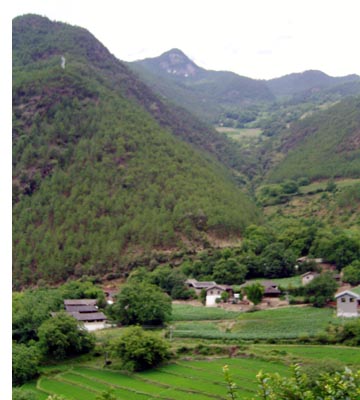 The road continues, with Tibetan monasteries and stupas dotting the hills and valleys. Becoming now more ethnically Tibetan, the buildings change; gone are the gray-tiled Naxi houses, replaced by the sturdy, solid, white plaster and mud brick walled, hard wood framed Tibetan style. The stupas, containing as they do remains of revered monks, are white washed, festooned with prayer flags, and well looked after. Monasteries high up in the mountains look well maintained. Passing along the mountain road to Xiang Gu Qing, home of the rare snub-nosed monkey, I spy a large white monastery way up in the mountain. It must have been at about 5,000 meters. The road is at 3,500. I ask the driver how to get up there. “Walk,” is the simple reply. He points to a trail. Fit enough just about for donkeys, I estimate it would be half a days climb. Yet looking through my binoculars, I see a huge complex, incense wafting up from the roofs, and a massive new construction going up to the right side of the monastery. It looks like it will become a bell tower, with another monastic hall attached. Marveling at how they manage to drag all the construction materials up I surmise that of course they don’t—the area is heavily forested. Yet there it is, a major new addition to the local Yellow Hat sect’s home. Regretting the fact I have no time to visit, I mark it down for a future trip. The views must be fantastic.
The road continues, with Tibetan monasteries and stupas dotting the hills and valleys. Becoming now more ethnically Tibetan, the buildings change; gone are the gray-tiled Naxi houses, replaced by the sturdy, solid, white plaster and mud brick walled, hard wood framed Tibetan style. The stupas, containing as they do remains of revered monks, are white washed, festooned with prayer flags, and well looked after. Monasteries high up in the mountains look well maintained. Passing along the mountain road to Xiang Gu Qing, home of the rare snub-nosed monkey, I spy a large white monastery way up in the mountain. It must have been at about 5,000 meters. The road is at 3,500. I ask the driver how to get up there. “Walk,” is the simple reply. He points to a trail. Fit enough just about for donkeys, I estimate it would be half a days climb. Yet looking through my binoculars, I see a huge complex, incense wafting up from the roofs, and a massive new construction going up to the right side of the monastery. It looks like it will become a bell tower, with another monastic hall attached. Marveling at how they manage to drag all the construction materials up I surmise that of course they don’t—the area is heavily forested. Yet there it is, a major new addition to the local Yellow Hat sect’s home. Regretting the fact I have no time to visit, I mark it down for a future trip. The views must be fantastic.
By the time I reach Zhongdian (recently renamed Shangri-La) the area has become almost completely Tibetan. When I visited last, the town was dusty, deserted, and downtrodden. I hated it. White tiled Chinese buildings with no character had taken over, poor attempts at Chinese-style “Tibetan” restaurants with “Tibetan” dancing, carried out by Han Chinese, had left me rather cold and depressed. But rather like the monastery, Zhongdian has had a complete overhaul. The “old town” (which is partially old, partially new) has a distinct Tibetan character to it, far removed from the previous shabbily thought out white tiled disasters that went for buildings. Traditional wooden structures, quaint streets packed with ethnic Tibetan goods, and Tibetans, lined the streets. The old town square had been cleaned up, as had its massive stupa, prayer flags fluttered in the breeze. I hadn’t expected this.
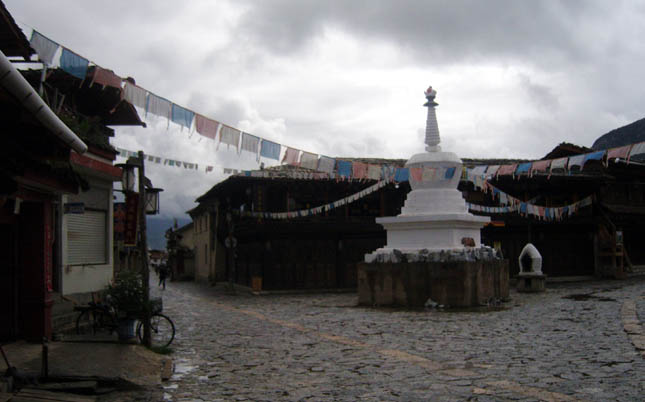
Back at the monastery, I receive blessings from the abbot as he placed a white silk scarf over my shoulders and muttered Tibetan incantations over my head. Lighting a yak butter candle in respect, I look around for photos of the Dalai Lama. I don’t really expect to see any, and I don’t, his image is still banned. But instead I see newer photos, of abbots and living Buddha’s incumbent, available, and revered by the locals and those who visit.
Leaving Zhongdian, I travel for six hours across the old Tea Horse trails further north. Again, the road is impressive; this route a few years ago would have taken two to three days. I pass the check point in to Deqin County, a massive area that borders Tibet, and home to just 80,000 people, most of them Tibetan. A Chinese policeman stops my car, and takes my passport. Writing details down, he returns it to me with a smile. “This is an ethnic Tibetan area,” he says. “We need to know who is here to protect them in case of problems.” I am impressed with his apparent sincerity over my well-being, but cannot also help wondering about what I am supposed to be protected against.
Reading that evening an account of Joseph Rock’s explorations in Tibet in the early 1930s, I am surprised by the problems he encounters. The Tibetans, it turns out, could be a savage lot. Traveling with an armed guard, he was frequently threatened, and on several occasions, attacked by bands of roving Tibetan bandits. I had thought all Tibetans were holed up in monasteries, praying for world peace and harmony while chanting that gravelly “om” noise and drinking endless cups of yak butter tea. But no, the Tibetans were a problem, a nuisance, and dangerous. When he reached Mudju, not far from where we currently were, Rock wrote, “The Konkaling outlaws, organized by a Tibetan Lama, had threatened to rob and kill us if we attempted to enter their lands.” He goes on to explain how the same bandits regularly raided local villages and lived off the pickings of caravans trading between Tibet and Zhongdian.
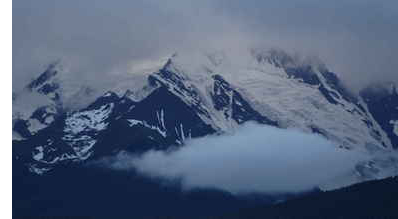 It was getting dark, but I wanted to press on a bit further. The driver had been shopping and I asked him what he had brought. He showed me a large knife. When asked to drive on, he advised not to. “It’s getting dark, and there can be problems here with people holding up cars in the evening,” he said. “That’s why I bought this knife.” We stayed at Fei Lai Si, overlooking the peak of Mount Kawa Karpo, rising to 6,720 meters and possibly the most beautiful mountain in China. Holy, its summit has never been climbed, and interestingly, it is a dead ringer for the perfect pyramid shaped peak James Hilton describes in his novel “Lost Horizon” when his party find themselves marooned in the mythical, near-perfect Himalayan paradise of Shangri-La.
It was getting dark, but I wanted to press on a bit further. The driver had been shopping and I asked him what he had brought. He showed me a large knife. When asked to drive on, he advised not to. “It’s getting dark, and there can be problems here with people holding up cars in the evening,” he said. “That’s why I bought this knife.” We stayed at Fei Lai Si, overlooking the peak of Mount Kawa Karpo, rising to 6,720 meters and possibly the most beautiful mountain in China. Holy, its summit has never been climbed, and interestingly, it is a dead ringer for the perfect pyramid shaped peak James Hilton describes in his novel “Lost Horizon” when his party find themselves marooned in the mythical, near-perfect Himalayan paradise of Shangri-La.
The Gompa at Fei Lai Se has also been renovated, and although small, it is in a stunning location. The next morning, the young monks beamed at me as I gulped back draughts of yak butter tea. A new college building was also being added, just as I had seen on the previous two monasteries. Intakes of monks had risen. I asked the abbot how life was under Chinese rule. “It’s OK”, he said. “Things have got much better. We can still grumble of course, but we are free to pray and practice and the monastery is flourishing. I can tell you it’s not too bad.”
The elderly monks words would echo my own. Despite the general opinion, Tibetan Buddhism is in fact flourishing in China. Indeed, the current state of religious affairs in Eastern Tibet reflects the fact that cultural beliefs are the living expression of a core carried in the hearts of its people. Despite persecution, and attempts to destroy it, as long as the will exists to hand it down to generations, it will survive, and at the appropriate time, once more prosper.
Additionally, we have to accept that historically, large areas of Tibet were nominally controlled by officials representing the Dalai Lama, with little subsequent change from completely independent little kingdoms, and semi-independent principalities. Much of Tibet, and certainly its eastern borders, operated not as a province but as a loosely organized federation of tribal states, a situation that continued, with obvious instability, petty skirmishes and banditry, until the Chinese moved to reorganize them in the 1950s.
Today however, the area is peaceful and serene. It was unfortunate for Tibet that its ruling party’s collapse into China occurred close to the time of the Chinese Cultural Revolution. But from what I can see, redress is continuing, monasteries are booming, and the religion of Tibetan Buddhism is undergoing resurgence without the necessity of having the Dalai Lama in position. The religion itself is far more deeply ingrained than having to rely on just one figurehead for support and direction. In fact it seems to be doing very well without him.
Old tales still die hard, such as my driver wishing to arm himself with a knife, but who is to know that he wasn’t correct? The Tibetan areas of China I traveled through seemed friendly and peaceful enough, but I am also sure that is strongly linked to the presence of the Chinese Police in the area to uphold the rule of law. Accordingly, in such an area with a history of banditry and murder, who can seriously deny that having a Chinese presence in Tibet is largely a stabilizing influence for the better?
Rule and law and order are one thing, and are the mark of a civilized society. China has brought that to Tibet. What is surprising now is the re-emergence of Tibetan Buddhism as a major religion, as China moves away from out and out atheism. It is obviously now encouraged, and the freedoms to worship and practice such beliefs now exist in both Tibet and China. As China opens up, so does Tibet, and it is now far easier to gain access to the country than it ever was. More roads, better communications, and an improved level of living quality have all come as a result of the Chinese involvement in the area. As this occurs, more access is given by Tibetan monks to Chinese and other visitors to Tibetan Buddhism and the Tibetan culture, and I believe this will have a positive effect, not a negative one. One cannot help but be moved by the serenity of a Tibetan temple. The more access people have to them, Chinese and otherwise, the better.
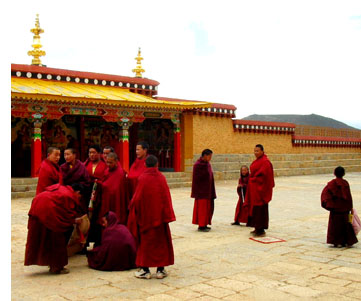 Consequently, I can report that the ethnic areas of Chinese Tibet are safe to travel, the Chinese have them under control, and freedom of religion as concerns Tibetan Buddhism in the area is flourishing. Both the indigenous Tibetans and the Chinese have made great progress in a region previously unstable, and that is an accomplishment that deserves to be credited, not criticized.
Consequently, I can report that the ethnic areas of Chinese Tibet are safe to travel, the Chinese have them under control, and freedom of religion as concerns Tibetan Buddhism in the area is flourishing. Both the indigenous Tibetans and the Chinese have made great progress in a region previously unstable, and that is an accomplishment that deserves to be credited, not criticized.
As a footnote, for those wishing to travel to the area, no special permits are required. Lodgings and hostels are in abundance at Lijiang (average cost around RMB80 per night), Zhongdian and Fei Lai Si (average cost around RMB20 a night). Shi Gu is not a regular tourist stopover but there are a couple of standard hotels that are acceptable at about RMB60 a night. The route took in Lijiang, Shi Gu, Zhongdian, Deqin and Fei Lai Si. I recommend at least five days for the one way journey in order to see as much and explore as much as you can. I recommend hiring a Toyota Landcruiser as the roads can get a little difficult when being repaired in the mountain passes. They can be hired in Lijiang for about RMB500 a day, including car, driver and all gas and other expenses. Happy travels.
Related articles:
Tibet Opens to Foreign Tourists
Olympic Torch Reaches Top of Mount Everest
The Tibet Issue
Improving China’s International PR Still Not On the Agenda
- Previous Article Tibet Opens to Foreign Tourists
- Next Article As ASEAN Develops, Kunming Becomes Vital Trade Link









